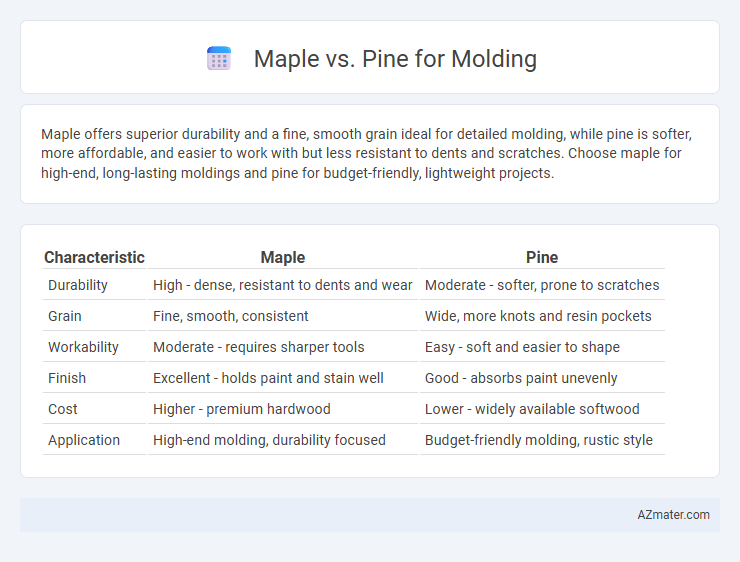Maple offers superior durability and a fine, smooth grain ideal for detailed molding, while pine is softer, more affordable, and easier to work with but less resistant to dents and scratches. Choose maple for high-end, long-lasting moldings and pine for budget-friendly, lightweight projects.
Table of Comparison
| Characteristic | Maple | Pine |
|---|---|---|
| Durability | High - dense, resistant to dents and wear | Moderate - softer, prone to scratches |
| Grain | Fine, smooth, consistent | Wide, more knots and resin pockets |
| Workability | Moderate - requires sharper tools | Easy - soft and easier to shape |
| Finish | Excellent - holds paint and stain well | Good - absorbs paint unevenly |
| Cost | Higher - premium hardwood | Lower - widely available softwood |
| Application | High-end molding, durability focused | Budget-friendly molding, rustic style |
Overview: Maple vs Pine for Molding
Maple offers greater hardness and durability compared to pine, making it ideal for molding that requires resistance to dents and scratches. Pine's softer texture allows for easier cutting and shaping, and it is more cost-effective, which suits budget-friendly molding projects. Both woods provide attractive grain patterns, but maple's fine, uniform grain offers a more polished appearance, while pine's rustic look fits traditional or country-style designs.
Wood Characteristics: Hardness and Durability
Maple offers superior hardness and durability compared to pine, making it ideal for molding that requires long-lasting structural integrity and resistance to dents or scratches. Pine, being a softer wood with lower Janka hardness, is more prone to dents and wears faster but is easier to work with and often more cost-effective. For molding applications demanding resilience and a polished finish, maple's dense grain and robustness provide enhanced performance over the lighter, softer pine.
Appearance: Grain Patterns and Color
Maple molding features a smooth, consistent grain pattern with a light, creamy color that can range from nearly white to a subtle golden hue, providing a clean and modern look. Pine molding has a more pronounced grain with prominent knots and a warm, yellowish-brown tone, offering a rustic and natural aesthetic. Choosing between maple and pine for molding depends on whether a sleek, uniform appearance or a textured, character-rich style is preferred.
Cost Comparison: Maple vs Pine
Maple molding generally costs more than pine due to its density and durability, which provide superior resistance to dents and wear. Pine is more affordable and widely available, making it a popular choice for budget-conscious projects, but it may require more frequent maintenance or replacement. The price difference between maple and pine molding typically ranges from 20% to 50%, influenced by regional availability and wood grading.
Workability and Ease of Installation
Maple offers superior hardness and density, providing a smooth finish that is ideal for detailed molding projects, but its higher density can make cutting and installation more labor-intensive compared to pine. Pine's softness enhances workability, allowing for easier cutting, shaping, and fastening, which simplifies installation and reduces the risk of splitting. When prioritizing ease of installation and workability, pine is generally preferred for moldings where intricate detail and durability are less critical.
Paint and Stain Compatibility
Maple offers a dense grain and smooth surface, making it highly compatible with both paint and stain, resulting in a flawless finish ideal for detailed molding work. Pine, with its softer texture and prominent knots, tends to absorb stain unevenly and may require a primer for consistent paint application. For molding projects demanding high-quality paint or stain outcomes, maple ensures superior adhesion and a more uniform appearance compared to pine.
Environmental Impact and Sustainability
Maple molding offers a more sustainable choice due to its slower growth rate and higher density, which contribute to longer-lasting products requiring less frequent replacement. Pine, being a fast-growing softwood, is more readily renewable but often sourced from plantations with varying environmental management practices that may impact biodiversity. Choosing responsibly harvested maple or pine certified by organizations like FSC ensures reduced deforestation and supports sustainable forestry practices.
Maintenance and Longevity
Maple molding offers superior durability and resistance to wear, requiring minimal maintenance over time compared to pine. Pine molding, being softer and more prone to dents and scratches, demands more frequent touch-ups and refinishing to maintain its appearance. The longevity of maple molding typically surpasses pine, making it a more cost-effective choice for long-term applications.
Best Use Cases for Each Wood Type
Maple offers exceptional hardness and fine grain, making it ideal for intricate molding details and areas requiring durability, such as baseboards and chair rails in high-traffic rooms. Pine, being softer and easier to shape, suits decorative applications like crown molding and rustic interior trim where a warm, natural look is desired. Choosing maple ensures long-lasting, smooth finishes in modern or formal settings, while pine provides cost-effective versatility for casual or country-style designs.
Final Recommendations: Choosing Between Maple and Pine
Maple offers superior hardness, durability, and fine grain, making it ideal for high-end molding projects requiring strength and a smooth finish. Pine, being softer and more affordable, suits decorative or budget-conscious applications where ease of workability and a rustic appearance are preferred. Selecting between maple and pine depends on balancing the need for durability and aesthetic quality against cost and intended use.

Infographic: Maple vs Pine for Molding
 azmater.com
azmater.com